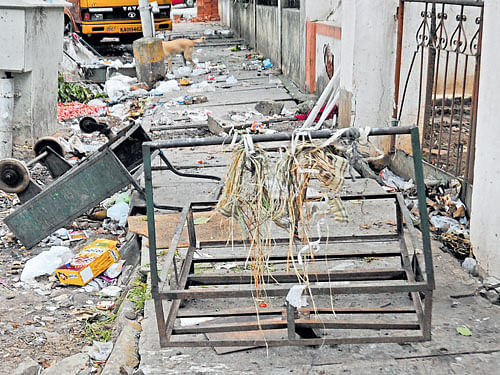
Were you forced to walk on the road because the sidewalk you were about to take was rickety, or had a monstrous transformer, or vehicles parked on it?
The latest on-field survey of 3,500 km of the arterial, subarterial and collector (inner) roads across the City has concluded that only 58 per cent of footpaths are pedestrian-friendly, while 42 per cent are reported ‘unwalkable’.
The study, ‘Street Quality Score (SQS)’, which was conducted by Janaagraha, an NGO, over the course of three months from September this year, also measured the quality of infrastructure, including pedestrian crossings, streetlighting, bus-stops and air pollution. The survey was aimed at creating a framework to measure the quality of life.
Footpath
The study identified that out of the 3,318 km of streets that was surveyed, only 1928 km had walkable footpaths, which is 58 per cent.
Footpaths in the outer zones were far worse than in inner zones, the report stated and added that it considered a footpath as walkable if two people could walk on it side by side without having to step onto the road, in the absence of any standard measure of walkability of a footpath.
In the report, unwalkability was considered based on the absence/gaps in footpath (44 %), missing and broken slabs (13%), transformers/ poles (8%), trees/plant overgrowth (7%), illegal construction (4%), hoarding/boards (1%), vehicle parking (7%), debris/stone (6%), garbage (5%), temporary storage (3%) and temporary food stalls (2%), which required both budget and enforcement.
“Collector roads connect residences to larger main roads and also house most community amenities but are the least walkable. Making these pedestrian-friendly would be the first step in creating walkable neighbourhoods,” the survey states.
More importantly, the study points out that the cost to build 1km of footpath is Rs 59.5 lakh and for 641km of footpath is Rs 381 crore, which is 7 per cent of the City budget. Gaps in footpath and obstructions can be simultaneously prioritised and addressed based on severity.
Out of 3,256 intersections that was surveyed, only 279 intersections (9 %) have usable pedestrian crossings. Of them, there were 94% zebra crossings (261 usable crossings), 2% subways (6 usable crossings) and 4% skywalks (12 usable crossings).
The study further states that there are six times more pedestrian crossings on arterial roads, 18 times more on sub-arterial roads and 35 times more on collector roads. Clearly, greater number of usable pedestrian crossings needs to be an immediate priority for better walkability in the City.
The study also highlighted that large parts of the City’s streets were poorly lit. Although the minimum safety requirement is 10 lux (brightness level) and the benchmark is 20 lux, the average lighting on 3,075 km of surveyed streets remained 8 lux.
It means that about 51 % of the city streets have lux levels below the safety benchmark of 10 lux, making them unsafe for pedestrians. Cubbon Road, Infantry Road and Varthur Road were in among the 127 wards, which are both partially lit and also have an average lux score below the minimum safety benchmark.
Bus stops
Out of 1,750 km of streets that was surveyed, only 665 km (i.e. 38 %) are serviced by bus-stops, the study further points out. On collector roads which connect citizens’ homes with the rest of the City, you are likely to find a bus stop every 2 km, which is four times the ideal walkable distance to a bus stop. The outer wards need more attention, given the greater road length and larger area but significantly lesser bus-stop coverage, according to the findings.
Air pollution
Out of 917 km of streets that were covered, PM 2.5 concentrations or fine particulate matter, which has a serious health concern, were found to be 40% higher than the permissible limit.
The principal source of PM 2.5 in cities is motor vehicles. As per the WHO guidelines, the benchmark for PM 2.5 is 25 μg/m3 (micrograms per cubic metre of air), where anything above it is considered harmful to health, the City has touched 35μg/m3.